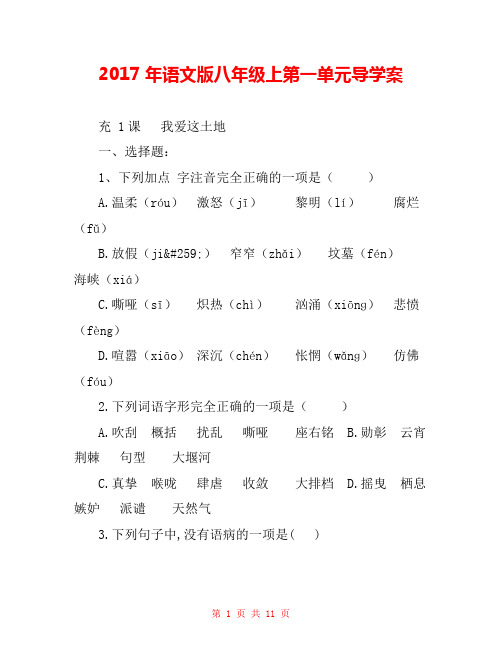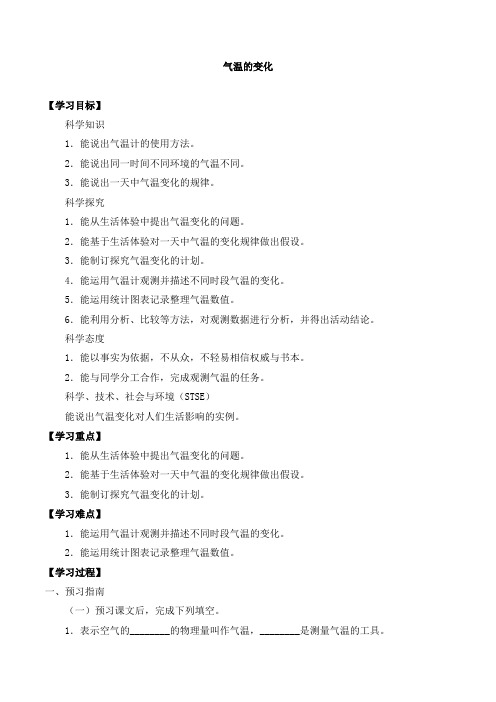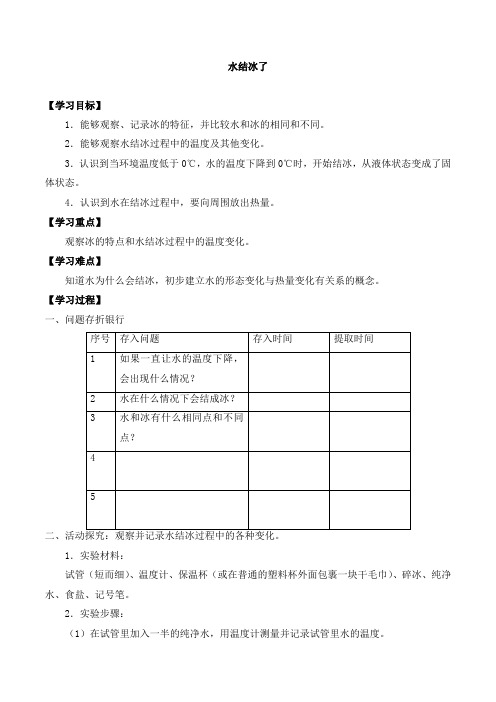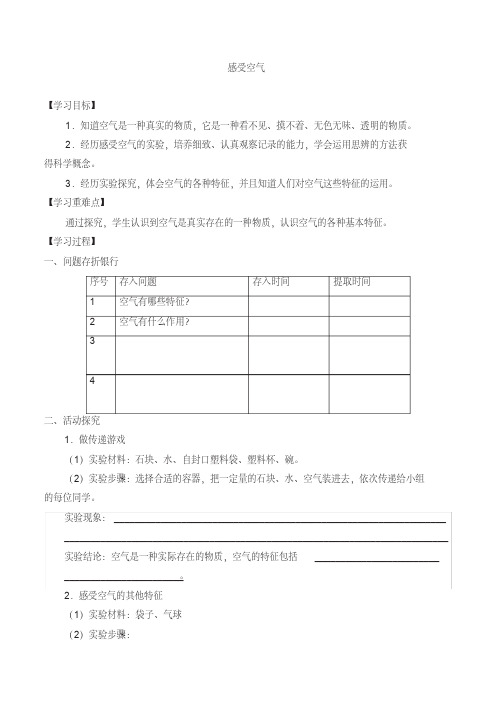2017导学案模板
- 格式:doc
- 大小:445.00 KB
- 文档页数:45

2017年语文版八年级上第一单元导学案充 1课我爱这土地一、选择题:1、下列加点字注音完全正确的一项是()A.温柔(róu)激怒(jī)黎明(lí)腐烂(fǔ)B.放假(jiă)窄窄(zhǎi)坟墓(fén)海峡(xiá)C.嘶哑(sī)炽热(chì)汹涌(xiōnɡ)悲愤(fèng)D.喧嚣(xiāo)深沉(chén)怅惘(wǎnɡ)仿佛(fóu)2.下列词语字形完全正确的一项是()A.吹刮概括扰乱嘶哑座右铭B.勋彰云宵荆棘句型大堰河C.真挚喉咙肆虐收敛大排档D.摇曳栖息嫉妒派谴天然气3.下列句子中,没有语病的一项是( )A.中国游客在境外旅游时的不文明行为被屡屡曝光,严重损害了中国礼仪之邦。
B.据报道,2016年12月中旬,中国雾霾范围进一步扩大至大约17个省市区左右。
C.《我在故宫修文物》是一部纪录片,它保留了故宫文化的气质和“工匠精神”的内核,近距离展示了稀世珍宝的“复活”技术。
D.2016年诺贝尔文学奖获得主是美国民谣艺术家、诗人、导演鲍勃迪伦获得的。
4.下列语句中加点的成语使用正确的一项是()A.与浩瀚的宇宙相比,我们渺小得无与伦比。
B.面对突出其来的大火,为了六条幼小的生命,王老师毅然跳入了火海。
C.桂林那些巧夺天工的奇山胜景吸了无数游客前来观赏。
D.他们的恩情我一直铭记于心,耿耿于怀。
5.下列语句的顺序排列正确的一项是()①正因如此,这一传播手段迅速被社会各界广泛运用。
②微博之所以如此受公众关注和追逐,是因为“沉默的大多数”在微博上找到了展示自己的舞台。
③任何受过教育的人,都能抒发自己的喜怒哀乐,表达自己的酸甜苦辣,展示自己的“名言警句”。
④微博没有任何门槛,无需任何包装,只要想说,就可以通过微博说出来。
A.②④③①B.④③①②C.③②④①D.①③④②二、默写:(5分)1.____ __,寒光照铁衣。

气温的变化【学习目标】科学知识1.能说出气温计的使用方法。
2.能说出同一时间不同环境的气温不同。
3.能说出一天中气温变化的规律。
科学探究1.能从生活体验中提出气温变化的问题。
2.能基于生活体验对一天中气温的变化规律做出假设。
3.能制订探究气温变化的计划。
4.能运用气温计观测并描述不同时段气温的变化。
5.能运用统计图表记录整理气温数值。
6.能利用分析、比较等方法,对观测数据进行分析,并得出活动结论。
科学态度1.能以事实为依据,不从众,不轻易相信权威与书本。
2.能与同学分工合作,完成观测气温的任务。
科学、技术、社会与环境(STSE)能说出气温变化对人们生活影响的实例。
【学习重点】1.能从生活体验中提出气温变化的问题。
2.能基于生活体验对一天中气温的变化规律做出假设。
3.能制订探究气温变化的计划。
【学习难点】1.能运用气温计观测并描述不同时段气温的变化。
2.能运用统计图表记录整理气温数值。
【学习过程】一、预习指南(一)预习课文后,完成下列填空。
1.表示空气的________的物理量叫作气温,________是测量气温的工具。
2.同一地点不同时刻,在一天内的气温是________的。
3.在测量时,要仔细观察气温计的________与________。
4.同一时间不同环境中的气温是_______的。
通常测量气温需要在______、______的草地上方,气温计离地面约_____米。
5.观测气温的活动步骤为:制订计划,确定_______、_______、观测时间间隔、_______。
6.一天中气温变化的大致规律是:_______气温较高,________气温较低。
1.确定测量气温的环境(二)理解与应用。
1.气温变化有规律吗?一天中气温是怎样变化的?2.同一时间不同环境的气温相同吗?测量并比较不同环境的气温。
在什么样的环境下测量一天中不同时间的气温比较合适?3.晴天和阴天的气温变化规律相同吗?4.气温变化比较大除了对衣着有影响之外,对生活还有哪些影响?【学习小结】通过学习你有什么收获?还有哪些需要努力的地方?【精炼反馈】一、小法官(对的在括号内打√,错的打×)1.藏袍的穿着方式,说明了一天中气温变化大对人们穿衣有间接影响。

2017年九年级上英语Unit8全单元导学案(牛津译林版)9A Unit8浠诲姟璁剧疆鐭ヨ瘑涓庢妧鑳?杩囩▼涓庢柟娉?杈炬垚鎯呭喌浣滀笟瀹夋帓Period 1 1.浜嗚В?2.3.?鈥滃厛瀛﹀悗鏁欙紝褰撳?鍩瑰吇瀛︾敓鐨勬帹鐞嗚兘鍔?Comic strip锛哤elcome to the unit ??Period 2 1.鏉€妗堢殑鏂伴椈鎶ラ亾 2.?3.鑳界悊瑙e拰杩愮敤鏂囦腑鐨勯噸鐐圭煡璇嗙偣?妯″紡鍩瑰吇闃呰?Reading 1 ??Period 3 瀛︾敓鑳?鈥滃厛瀛﹀悗鏁欙紝褰撳?妯″紡銆?Reading 2 ??Period 4 1. 瀛︿細杩愮敤闄愬埗鎬у?2. 瀛︿細杩愮敤鍏崇郴浠h瘝鈥滃厛瀛﹀悗鏁欙紝褰?妯″紡€?Grammar??Period 5 1.?2. 鏍规嵁鎵?粌鈥?妯″紡Integrated skills缁冦€??Period 6 1. 浜嗚В?2. 瀛︿細鐢ㄩ€傚綋鐨勬柟娉曢槄鈥滃厛瀛﹀悗鏁欙?妯″紡瀛︿細鐢ㄩ€傚綋鐨勬柟娉曢槄璇诲皬璇?Study skills??Period 7 1. 灏嗗彞瀛愬拰鍥剧墖閰?2.鐨勭粨灏??妯″紡缂栧啓涓€鍒欎睛鎺㈡晠浜?Task ??Unit 8 Detective stories璇?棰?Comic strip and welcome to the unit 璇?鍨?鏂版巿璇炬椂1 璇炬椂鏁?瀛?鐩?鏍?1. To understand clues about a crime. 2. To read notes on four suspects and decide which suspect is most likely to be guilty.閲嶇偣1. To master the new words and useful expressions. 2. To make up a conversation in Part B. 1. To master the new words and useful expressions. 2. To make up a conversation in Part B. ?浜屾Teaching procedures Step1 Lead-in T: Do you remember in Unit 6 we have learned a horror film called 鈥淢urder in a Country House鈥? Can you tell me the main idea of this film? Step 2 Comic strip 1. Presentation: T: Do you like reading detective stories? Who is the famous detective in the novels? (Sherlock Holmes.) Show the picture of Sherlock Holmes, and describe the picture. (Talk about his special dressing with his magnifying glass and the pipe.) T: Today, Eddie is dressed like that. Let鈥檚see what happened. 2. Listen to the tape and answer some questions: (1) Why is Eddie dressed like a detective? (2) Is his job serious? (3) What is he really looking for? Check the answers by asking students. 3. Read the dialogue together. 4. Ask some pairs to act out the dialogue. Step 3 Welcome to the unit 1. Presentation T: Do you want to be a detective? How to be a detective? Here is a chance for you to try. The Class1, Grade 9 students are playing a game about guessing who is the murder. We can try together. 2. Show the detective鈥檚report to students. Ask one student to read. Tell students that we can know the time, the place, the victim and the notes of the suspects from the report. 3. Look at the information of four suspects together and ask some questions about it. Teach some new words at the same time. Try to explain the meanings of these words in English. Step 4 Discussion Work in a group offour. Ask students to discuss who is most likely to be the murderer and the reason. Then ask them to draw a picture of the person they think committed the crime in part B, and remind them that there is no right or wrong answers here. Step 5 Part B Daniel and Sandy are talking about the murder in Sun Town. Listen to the conversation and answer the questions: (1) Who does Sandy think is mostly to be the murder? Why? (2) Who does Daniel think is most likely to be the murder? Step 6 Consolidation ?1. Why__________ you __________(dress) like that? 2. Eddie鈥檚food has gone __________(miss). 3. The coats with blood were those ____________(murder). 4. His bedroom istoo_________(tidy). Let鈥檚_______(help) to clean it. Step 7 Homework 1. Read the comic strip and try to recite it. 2. Finish off the exercises in the workbook. 鏁欏?璇?棰?Reading (1) 璇?鍨?鏂版巿 2 璇炬椂鏁?瀛?鐩?鏍?11.1. To read a newspaper article about a murder. 2. To understand key vocabulary items. 3. To develop the four skills of the students. 1. To learn new words from the context. 2. To retell the passage. 1. To learn new words from the context. 2. To retell the passage. ?Teaching procedures Step 1 Presentation 1. Say: Good morning, everyone. First of all, let鈥檚watch a part of a film. 2. Say: Just now we saw a young man in the film. What did he do? Yes, he murdered the woman, his wife. He was the murderer. And his wife is the victim. (Write the two words on the Bb.) Learn the new words. Step 2 Listen and answer Now listen to the tape and try to answer some questions: 1. Who was murdered? 2. When did the murder take place? 3. So far how many suspects do the police have? 4. How old was the victim? 5. What鈥檚the victim鈥檚job? Step 3 Skimming 1. Ask the students to finish the exercise of Part B1, then check their answers by asking 2 pairs of students to read it. 2. Ask the students to work in pairs and tick out the main idea of the article. (slide show) the victim:clues: suspects: the police: 3. Check out their answers orally, then give out the answers on pieces of paper. 4. Interview: Work in groups of 8. Four work as the reporter, who is from the Golden TV, the other four work as Detective Lu. Interview about the murder. 5. Act their interviews out. 6. Guess: Who murdered the young man? 7. Finish the exercises in Part B2 on P110. Step 4 Practice 1. The drunk man__________(鍙戠幇) in the __________(闂ㄥ彛) of the neighbour鈥檚. 2. Mike is one of the ______________ (? who ___________(鎶㈠姭). 3. Theymust________() their air tickets 3 days before they leave. 4. His dog鈥檚_________(姝? made him very sad. 5. When she woke up, her headwas_________() 6. Have you seen anything_______________(鎬€鐤?? 7. He was last seen _______ (绂诲紑) his office at about 7 p.m. 8. Today he got up as early as ___________(寰€甯? 9. A young man_________________(璋嬫潃) last night. 10. Shall we meet at the __________(鍏ュ彛) to the cinema? Step 5 Homework 1. Remember the new words and phrases. 2. Retell the text in their own words. 鏁欏?璇?棰?Reading (2) 璇?鍨?鏂版巿3 璇炬椂鏁?瀛?鐩?鏍?1. To read a newspaper article about a murder. 2. To understand key vocabulary items. 3. To develop the four skills of the students. 鏁欏To learn the new words and the phrases in this part. To learn how to use the language points correctly. ?Teaching procedures Step 1 Revision Read the article more carefully and try to tell the following sentences T or F. If it is false, please correct the mistake. a) The victim鈥檚body was found in Valley Town. ____ b) The victim sold computer programs. ____ c) The victim worked in New Town. ____ d) It is possible that there was more than one attacker. ____ e) The victim had lots of enemies. _____ f) The victim was attacked with a gun. ____ g) The suspect is a short, fat man. _____ h) The police have arrested the murderer. _____ i) The victim鈥檚parents offered a reward for information. ____ Step 2 Reading Read the article by themselves forseveral minutes then ask 8 students to read one paragraph by one paragraph. While reading, after each paragraph, do some explanations about the difficult points. Also do some explanations about the title. Show the students more examples. Step 3 Important phrases see sb. doing sth. ---sb. be seen doing sth.鍋?see sb. do sth.---sb. be seen to do sth. ?at thescene/time of the crime ?鏃堕棿somewhere else鍦版柟be wounded with a knife bleed to death(bled) as a result 缁撴灉as a result of = because of a well-paid job 涓€浠芥姤be guilty of 鈥?feel/be guiltyat/for/about 瀵光€︹€︽劅鍒板唴鐤?charge sb. with (doing) sth. 鍥犳煇浜嬭€屾帶鍛婃煇浜?be charged with sth.у憡break into岀牬闂ㄨ€屽叆make enemies with sb. 涓庢煇浜烘爲鏁?suppose sb. to do sth. 璁炬兂鏌愪汉鍋氭煇浜?so far = up to now=until now=by now鍒扮洰鍓嶄负姝?breathe heavily/hard=out of breath 姘斿枠鍚佸悂Step 4 Practice 1. Finish the exercises in B3 and B4. 2. Show some pictures and key words, Ss try to retell the passage in their own words. Step 5 Consolidation 鐢ㄦ墍缁欒瘝鐨勯€傚綋褰㈠紡?1. Come here, jack. You _____________(want) on the phone. 2. No one ____________(travel) farther than the moon so far. 3. My food ______(go)_________(miss). 4. He is listening ______________(close) to the teacher. 5. They were ____________(scare) at the strange noise. 6. Look at the ___________(follow) examples, please. 7. A dictionary tries to tell the different _______(mean) of a word.8. The ____(interview) asked him how many crimes he had solved. 9. What is his____________(high) 10. There were more than one _______(attack). Step 6 Homework 1. Remember the language points. 2. Preview Grammar. ?璇?棰?Grammar 璇?鍨?鏂版巿 4 璇炬椂鏁?瀛?鐩?鏍?1. To understand and use defining relative clause correctly. 2. To use relative pronouns correctly: who/ which/ that. 1. To understand anduse defining relative clause correctly. 2. To use relative pronouns correctly: who/ which/ that. To use relative pronouns correctly: who/ which/ that.?Teaching procedures Grammar A Step 1 Lead-in Go through the explanation at the top of page112. Encourage students to ask questions if there is anything they are unsure of. Give students extra examples if necessary. Step 2 Reading 1. Explain the context. Millie is writing down some sentences about the murder case. Ask students to read sentences and decide which contain defining relative clause. 2. More able students underline the defining relative clauses. Allow less able students to work in pairs. 3. When all students have finished, ask two students to read the sentences. Ask them to stop after each sentence and the other students raise their hands and say if it contains a defining relative鈥檚clause. Check for mistakes and mispronunciation. 4. Ask students to think of some famous people from China. Encourage them to think of great people, rather than famous film stars. Write the names on the board. e.g. Yang liwei Yuan Longping He Zhengliang Step 3 Practice 1. Have students get into pairs and ask each pair choose a famous person from China. Ask them: What is this person famous for? How has he/ she helped China? How has he/ she helped society? 2. Each pair works out the answers to the questions for the person they have chosen. Then each pair reads out their answers. 3. Ask students to think about what structure the object clauses and defining relative clauses. Check out check the previewed exercises as usual. Step 4 Consolidation 鎶婁袱鍙ュ悎骞舵垚涓€鍙? 1. The boy is Tom. The boy has a round face. 2. The boy is Tom. The boy is smiling. 3. The boy is Tom. He sits in front of me. 4. The man is kind. Everyone likes him. 5. The woman got the job. We saw her on the street. 6. The teacher will give us a talk. We met the teacher yesterday. Step 5 Homework 1. Finish the exercises in the workbook. 2. Write ten defining relative clauses. 1. Remember the new words in this lesson. Grammar B Step 1 Lead-in Go through the table at the top of page 113. Then read the two example sentences. Tellstudents that the arrows show the people or things the relative pronouns are referring to. Step 2 Explanation 1.Explain the context of the exercise. Students can work in pairs or small groups. 2. Explain to students that both 鈥榳hich鈥?and 鈥榯hat鈥?can be used as relative pronouns to refer to things, but we normally use鈥榯hat鈥?as the relative pronoun when the noun it refers to is qualified by an ordinal number, e.g. 鈥榯he first鈥? 鈥榯he second鈥? 鈥榯he last鈥? 3.兘鐢╰hat鐨勬儏鍐碉細(1)?This is the best novel that I have read. (2) 褰撳厛琛岃瘝鏄痵omething, anything, nothing, everything, all绛変笉瀹氫唬璇嶆椂锛?Is there anything that I can do for you? (3) 褰撳厛琛岃瘝琚玹he only, the last, one of, just, all, little, few, any He is the only student that can sing this song. (4) 褰撳厛琛岃瘝鍚屾椂鎸囦汉鍜岀墿鏃讹紱I鈥檝e never heard of the people and things that you talked about just now. (5) 褰撲富鍙ヤ互who鎴栬€厀hich寮€澶寸殑鐗规畩鐤戦棶鍙ユ椂锛?Who is the man that is running? Step 3 Practice Simon and his friends are playing a game. Each person has to say say something about detective stories. Use who, which and that to complete the conversation. Finish the exercises in PartB2 and B3. Step 4 Consolidation 鐢ㄥ叧绯讳唬璇嶅~绌恒€?1. The boy____________ is playing ping-pong is my classmate. 2. The last e-mail __________ I received yesterday was from my sister. 3. I hate people ______________ talk much but do little. 4. The car ______ my father bought last month is very beautiful. 5. Yesterday Emily was wearing the new dress I gave her. Step 5 Homework Finish the exercises in the workbook. 璇?棰?Integrated skills 浜猴細璇?鍨?鏂版巿5 璇炬椂鏁?瀛?鐩?鏍?1. To get the information from the listening text. 2. To use information to complete notes and a report.1. To get the information from the listening text.2. To use information to complete notes and a report. 闅剧偣To use information to complete notes and a report. ?Teaching procedures Step 1Lead-in If someone has been kidnapped, can you ask Eddie for help? Who do you think find out the kidnapper? Now a child called Guan Fei has been kidnapped. His father, Guan Dawei asked the police for help. A police officer made some notes. Please read his notes and answer the following questions: 1. How old is the victim? 2. When did the crime occur? 3. Who are suspects? Step 2 Read and write Read the notes and complete the profiles with as much information as possible. Step 3 Listen and write If the police officer wants to find out who was the kidnapper, he should interview the two suspects. Here鈥檙e the police officer鈥檚interviews with them. Listen to their interviews carefully! 1. Listen and get the main idea. 2. Listen and complete the suspects鈥?profiles on Part A1, on Page 115. 3. Listen and check the answer. Step 4 Listen and answer Listen to the police officer鈥檚interviews with the two suspects again and answer the following questions: 1. What is Fan Yiming鈥檚job? 2. How long has Wang Gang known Guan Dawei? 3. What about Fan Yiming? 4. Did the two suspects go to the Guan鈥檚house on 28th December? 5. Where was Wang Gang at 8 p.m on 28th December? 6. Why did the kidnapper kidnap Guan Fei? Step 5 Read and write The police officer wants his assistant to write a report on the kidnapping case. Please help him complete Part A3. Use the notes and profiles on page 115 to help you. 1. Read and write. 2. Check the answers. 3. Let Ss read it freely. Step 6 Speak up Mr. Wu is asking Ss to think of some safety tips against crime. Listen to the tape and find out some safety tips: We should remember to 鈥? We鈥檇better shut 鈥? We shouldn鈥檛鈥? We need to guard 鈥? Step 7 Consolidation 1. He has no ___________(crime) record. 2. The girls ________________(kidnap) last night. 3. What do you think of _________(go) to the zoo today? 4. Jonson is a__________(kidnap). 5. He_______________(wear) a black T-shirt. Step 8 Homework 1. Revise this period. 2. Preview Study skills. ?璇?棰?Study skills 璇?鍨?鏂版巿 6 璇炬椂鏁?瀛?鐩?鏍?To learn to read a novel in the proper ways. To learnto read a novel in the proper ways. To learn to read a novel in the proper ways. 鏁欏?Teaching procedures Step 1 Checking & Leading ?1. He grew up in a _____________(wealth) family. 2. The young man is guilty of ______ (kidnap) a little girl. 3. It鈥檚_____ (danger) for children to go out alone at night. 4. You鈥檇better _______(not make) so much noise in the library. 5. We _______ (know) each other since we were young. 6. I鈥檓in no hurry ____________(see) him again. 2. Teaching the new words. 3. Do you often read novels? If so, do you read them word by word or just read quickly to get the general idea? Step 2 Learning 1. Read an excerpt from A Study in Scarlet on page117, then answer the following questions. 1) Who was the murderer, a man or a woman? 2) What was the murderer like? 3) How was the murder done? 4) What is the meaning of 鈥淩ache鈥?in German? 2. Read the excerpt again. Step 3 Practice There are some new words in the excerpt, and some sentences with more different words are left out. But you can still answer the four questions that help you get the general idea of the story. Can you answer two more questions? 1. Who were the other two detectives? 2. Who were the two detectives looking for? Step 4 Testing 1. 鈥昗hat did he do for a_______(live) last year? 鈥旾have no idea. 2. The murderer was a man. He was more than six ____(foot) high. 3. Jane planned _____(take) the wallet to the owner the next day. 4. To Kevin鈥檚_______(surprising), he found so many people playing beach volleyball in very hot weather. 5. I hope my advice willbe_________________(value) to you. Step 4 Homework 1.嬬浉鍏崇粌涔犮€?2. Preview Task.璇?棰?Task 璇?鍨?鏂版巿7 璇炬椂鏁?瀛?鐩?鏍?1. To match sentences with pictures. 2. To complete a story by filling in blanks.To write a detective story. To write a detective story.?Teaching procedures Step 1 Part A 1.Encourage more able students to describe the four pictures at the top of the page. 2. Ask questions: What is happening in picture 1? What is the man going to do in picture 2? Can you describe something about picture? What happened to Bruce? 3. Work in pairs. Ask students to match the sentences with the pictures by writing the correct letter in each box. 4. Ask students to read out their answers. Step 2 Part B Tell students to complete Part B individually. They should use the words from Part A to complete Millie鈥檚story. Check the answers as a class. And read it together, discuss the end of the story. Have a discussion in a group of four. Step 3 Part C 1. Look at the pictures in Part C. Ask six students to read out one speech bubble each. 2. Ask the following questions: Who do you think was murdered---a man or woman? How do you think he/ she was killed? Is there any blood? Who do you think is guilty? Why do you think he/ she is guilty? Step 4 Writing Explain the elements in writing detective stories. Tell students to write their own detective stories. Read their own detective stories. Step 5 Consolidation 1. Jim spends 3 days___________(finish) the work. 2. The next day, he____________(take) it to the factory. 3.He__________(leave) without___________(say) a word. 4. He is ill. He isunable_____________(get) up. 5. He said he _________(visit) Suzhou gardens many times before. Step 6 Homework 1. Do the exercises in the great English class. 2. Finish writing the detective story that they haven鈥檛finished in class.。

水结冰了【学习小结】通过本节课的学习,我们知道了水和冰既有相同点:没有颜色、没有气味,透明,又有不同点:冰——有固定形状、不会流动、坚硬,水——无固定形状、会流动、柔软。
水结成冰以后,形态发生了改变,从液体变成固体。
通常情况下,水在0℃时开始结冰,水的状态发生变化的根本原因就是由于热量的变化。
在本课中我们还进行了科学实验。
科学实验是一项严肃的活动,我们必须按照要求,科学、规范地实验。
此外,我们还要注意观察、认真思考、仔细分析,只有这样,才会有收获!【精炼反馈】一、判断下列说法是否正确,对的打“√”,错的打“×”。
1.水结冰后,温度将一直保持不变。
()2.把冰放人水中,冰会浮在水面上。
()3.在碎冰中加食盐会使碎冰的温度上升。
()4.隔着冰可以看见物体。
()5.水结冰后,形态变了,但体积不变。
()二、选择正确答案的序号填在括号里。
1.使水的形态发生变化的主要原因是()。
A.温度B.透明度C.硬度2.水在结冰过程中与周围环境的热量交换情况是()。
A.要从周围环境中吸收热量B.要向周围环境释放热量C.既不从周围环境中吸收热量,也不向周围环境释放热量3.关于水结冰的实验,下列说法正确的是()。
A.应选用粗一点的试管B.应该在试管中加满水,因为水结冰后体积会缩小C.测量温度时温度计不能碰到试管内壁4.为了使冰水混合物的温度降低,可以采用的方法是()。
A.加水B.搅拌C.加盐三、完成下面的填空。
1.水蒸发可以在()(填温度条件)进行;水沸腾的温度是();水结冰的温度是()。
2.水蒸气凝结成小水珠要向周围环境()热量,水结成冰要向周围环境()热量。
(填“吸收”或“释放”)四、综合探究。
1.自然界中的冰水混合物,冰既不融化,水也不结冰,此时的温度一定是0摄氏度,为什么?(标准大气压下)2.下面是某小组在做水结冰实验时的相关记录,请根据记录表回答后面的问题。
(1)碎冰的温度比水的初始温度(),比0℃()。

感受空气【学习目标】1.知道空气是一种真实的物质,它是一种看不见、摸不着、无色无味、透明的物质。
2.经历感受空气的实验,培养细致、认真观察记录的能力,学会运用思辨的方法获得科学概念。
3.经历实验探究,体会空气的各种特征,并且知道人们对空气这些特征的运用。
【学习重难点】通过探究,学生认识到空气是真实存在的一种物质,认识空气的各种基本特征。
【学习过程】一、问题存折银行序号存入问题存入时间提取时间1空气有哪些特征?2空气有什么作用?34二、活动探究1.做传递游戏(1)实验材料:石块、水、自封口塑料袋、塑料杯、碗。
(2)实验步骤:选择合适的容器,把一定量的石块、水、空气装进去,依次传递给小组的每位同学。
实验现象:________________________________________________________________ __________________________________________________________________________实验结论:空气是一种实际存在的物质,空气的特征包括________________________ _______________________。
2.感受空气的其他特征(1)实验材料:袋子、气球(2)实验步骤:①袋子口,兜入空气,使袋子鼓起来,然后扎紧袋口,用两手轻轻触摸装入的塑料袋。
你有什么感觉?②将装满空气的袋子上刺一个小孔,挤一挤能听到声音么?把手放在小孔处,你能感觉到什么?③按一按气球的形状会改变吗?手放开后,气球会回复原来的样子吗?④把气球充满气,然后扎紧气球口,用手向上抛起气球。
你观察到了什么?(3)实验记录实验步骤实验现象①②③④(4)实验结论:空气的特征还包括______________________________________________。
三、理解与应用1.你认为空气还有哪些特征?你是如何知道的?2.空气、石头、水相比较,有哪些相同的特征呢?【学习小结】这节课我们通过感受空气,知道了空气是一种真实的物质,它是一种看不见、摸不着、无色无味、透明的物质。

2017部编版小学一年级语文下册识字4《猜字谜》导学案表格式教案部编版小学一年级语文下册识字4《猜字谜》导学案表格式教案课题猜字谜课型新授课《语文课程标准》指出:识字和朗读是低年级语文教学的重点。
本课的内容对于学生来说充满趣味性。
根据所学内设计说明容和学情特点,本着激发学生猜字谜的学习兴趣的目的,故采用猜字谜导入,自主识字,探究新知,拓展延伸的教学策略。
1.搜集字谜。
(学生)课前准备2(制作相关的多媒体课件,词卡、字卡。
(教师)课时安排 1课时教学过程教学环节教师指导学生活动效果检测1、课件出示字谜。
1、学生猜字谜。
(1)玉被口吃掉。
(1)国。
(2)“玉”上五瑕疵。
1、我能找几个字谜写一写。
一、猜谜游戏,导入新(2)王。
课(用时:5分钟) 2、板书课题:猜字谜。
__________________2、学生齐读课题。
3、教师引问:你们喜欢猜字谜吗,3、学生汇报交流自己的感受。
(注意引导学生说完整的话。
)1、出示自学要求。
1、小组内根据自学要求进行讨论交1、汉字迷宫流。
(1)初读儿歌,借助拼音读准生字。
猜字谜。
(1)学生读生字。
(2)自由读儿歌,将容易读错的生字多白担心。
() 二、初读课文,学习字读几遍,直到读通为止。
(2)自由读课文,根据注音读通句词(用时:10分钟) 子。
今天出点汗。
()2、指导交流。
2、在教师指导下汇报交流。
2、唱反调。
写出下面字的反义(1)出示生字。
请学生当小老师领读难词。
读的生字。
(1)当小老师领读难读的生字。
静——()(2)教师相机指导“遇”是整体认读音(2)再次明确整体认读音节及翘舌节:“纯”是翘舌音。
音的读法。
左——()3、同桌交流识记方法。
3、在教师指导下同桌交流识记方3、把会读的词语涂上喜欢的颜法。
色。
4、汇报交流。
相机指导学生运用多种方法识记生字,鼓励学生用猜字谜法识记生4、学生交流识记生字的方法。
相遇喜欢纯净字。
5、在教师指导下巩固识字。
互相感动最怕5、巩固生字。
目录第一章 三角函数1.1.1 任意角 ..........................................................................................1 1.1.2 弧度角 ..........................................................................................5 1.2.1 任意角的三角函数(1) ........................................................................8 1.2.1 任意角的三角函数(2) ........................................................................12 1.2.2 同角三角函数的关系(1) .....................................................................15 1.2.2 同角三角函数的关系(2) .....................................................................17 1.2.3 三角函数的诱导公式(1) .....................................................................19 1.2.3 三角函数的诱导公式(2) .....................................................................22 1.2.3 三角函数的诱导公式(3) .....................................................................25 1.3.1 三角函数的周期性 ...........................................................................27 1.3.2 三角函数的图象和性质(1) ..................................................................30 1.3.2 三角函数的图象和性质(2) ..................................................................33 1.3.2 三角函数的图象和性质(3) ..................................................................36 1.3.3 函数)sin(ϕω+=x A y 的图象(1) ......................................................38 1.3.3 函数)sin(ϕω+=x A y 的图象(2) ......................................................41 1.3.4 三角函数的应用.................................................................................44 三角函数复习与小结 (46)第二章 平面的向量2.1 向量的概念及表示..............................................................................49 2.2.1 向量的加法.......................................................................................52 2.2.2 向量的减法.......................................................................................55 2.2.3 向量的数乘(1) .................................................................................58 2.2.3 向量的数乘(2) .................................................................................62 2.3.1 平面向量的基本定理 ........................................................................65 2.3.2 向量的坐标表示(1) ........................................................................68 2.3.2 向量的坐标表示(2) ........................................................................70 2.4.1 向量的数量积(1) ...........................................................................72 2.4.1 向量的数量积(2) (75)第三章 三角恒等变换3.1.1 两角和与差的余弦公式 .....................................................................77 3.1.2 两角和与差的正弦公式 .....................................................................81 3.1.3 两角和与差的正切公式 .....................................................................85 3.2.1 二倍角的三角函数(1) .....................................................................88 3.2.1 二倍角的三角函数(2) (92)第一章 三角函数 1.1.1 任意角【学习目标】1. 了解任意角的概念;正确理解正角、零角、负角的概念2. 正确理解终边相同的角的概念,并能判断其为第几象限角,熟悉掌握终边相同的角的集合表示【学习重点、难点】用集合与符号语言正确表示终边相同的角 【自主学习】 一、复习引入问题1:回忆初中我们是如何定义一个角的?______________________________________________________ 所学的角的范围是什么?______________________________________________________ 问题2:在体操、跳水中,有“转体0720”这样的动作名词,这里的“0720”,怎么刻画? ______________________________________________________ 二、建构数学 1.角的概念角可以看成平面内一条______绕着它的_____从一个位置_____到另一个位置所形成的图形。
高效课堂导学案
学科语文二年级上册第八单元学校:主备人:
高效课堂导学案
学科语文二年级上册第八单元学校:主备人:
高效课堂导学案
学科语文二年级上册第八单元学校:主备人:
高效课堂导学案
学科语文二年级上册第八单元学校:主备人:
高效课堂导学案
学科语文二年级上册第八单元学校:主备人:
高效课堂导学案
学科语文二年级上册第八单元学校:主备人:
高效课堂导学案
学科语文二年级上册第八单元学校:主备人:
高效课堂导学案
学科语文二年级上册第八单元学校:主备人:
高效课堂导学案
学科语文二年级上册第八单元学校:主备人:
高效课堂导学案
学科语文二年级上册第八单元学校:主备人:。
我们衣服的材料【学习目标】1.科学知识知道人们可以采用不同的材料制作衣服以满足不同的需要。
知道我们的内外衣服制作材料的不同是因为材料性能不同,这样才能满足我们不同的需求。
知道衣服的制作材料是制造技术的产品,工程和技术产品改变了人们的生产生活。
2.科学探究在教师指导下开展衣服材料调查,记录、统计调查结果,并作出衣服材料性能的假设。
设计实验了解衣服材料的结构特点,推测、检验衣服材料性能的假设。
查询、阅读资料,了解衣服制作材料的变迁。
3.科学态度积极参与调查、实验等活动,乐于合作与分享。
了解我国衣服材料制作技术的发展,增强民族自豪感。
4.科学、技术、社会与环境(STSE)了解并意识到随着科技的发展,人们制作衣服的材料越来越丰富。
【学习重点】了解我国衣服材料制作技术的发展,增强民族自豪感。
【学习难点】设计实验了解衣服材料的结构特点,推测、检验衣服材料性能的假设。
4.把棉布、毛料、合成纤维、丝绸这几种衣料分别紧紧套在手电筒上,用放大镜仔细观察,它们有什么相同和不同?5.把砂纸固定在桌上,把棉布、毛料、合成纤维、丝绸这几种衣料分别包在一个木块上,在砂纸上磨,比一比哪种衣料最耐磨?你发现了什么?衣料还有哪些特点?6.查阅资料,说一说从古至今,人们制作衣服的材料是怎样发展的?【学习小结】通过经历“调查我们的衣服是用什么材料做的”、“研究我们的衣料具有什么性能”、“了解衣服材料的发展”三个活动探究,能够亲身开展衣服材料的调查、统计,并根据调查结果针对材料的性能做出合理的假设;能够以实验等方式对假设予以检验;通过查询、阅读资料等方式,能够了解衣服制作材料的变迁。
【精炼反馈】一、小法官(对的在括号内打√,错的打×)1.人们可以采用不同的材料制作衣服以满足不同的需要。
()2.我们的内外衣服制作材料的不同是因为材料的性能不同。
()3.人类只能使用材料,而无法制造新的材料。
()二、取出珍宝(把正确的序号填在括号内)1.()衣料柔软、透气性好。
'. ;. 丹寨县城关第一小学导学案设计
年 级 四年级 单元 第一单元 主备人 潘正琴 执教人
时 间 课题 第1课古诗词三首
教学 目标
知识 与 能力 能用自己的话说出诗句意思,并由此想象画面。
过程与 方法
1.会认读本课中“螺”“谙”等生字,会写“亭”“庭”“潭”“螺”“谙”5个生字,理解“闲”“厌”“和”“谙”等词在诗句中的意思。 2.有感情地朗读、背诵三首诗,默写《独坐敬亭山》《望洞庭》。 3.搜集、背诵别的描写山水风光的古诗。 情感态度与价值观 读懂三首古诗,感悟每首诗中描绘的独特景色,体会表现手法。
教学重点 1.会认读本课中“螺”“谙”等生字,会写“亭”“庭”“潭”“螺”“谙”5个生字,
理解“闲”“厌”“和”“谙”等词在诗句中的意思。 2.有感情地朗读、背诵三首诗,默写《独坐敬亭山》《望洞庭》。
教学 难点 1.会认读本课中“螺”“谙”等生字,会写“亭”“庭”“潭”“螺”“谙”5个生字,
理解“闲”“厌”“和”“谙”等词在诗句中的意思。 2.有感情地朗读、背诵三首诗,默写《独坐敬亭山》《望洞庭》。
课前 准备 相关PPT
学 习 过 程(第一课时) 环节 导 案 学 案
二次备课
看 一 看
导入新课 我们先进行课外知识抢答,唐朝是我国古诗创作最旺盛的时期,在众多诗人中有两个最有名的诗人,他们是谁? (根据学生课堂反应,教师提示:一个称“诗仙”,一个称“诗圣”) 出示学习目标
1.会认读本课中“螺”“谙”等生字,会写
明确学习目标 '. ;. “亭”“庭”“潭”“螺”“谙”5个生字,理解“闲”“厌”“和”“谙”等词在诗句中的意思。 2.有感情地朗读、背诵三首诗,默写《独坐敬亭山》《望洞庭》。 3.搜集、背诵别的描写山水风光的古诗。
议 一 议
合作探究问题设计: 1.读题,看注释,结合插图,教师介绍背景。 2.引语:“李白坐在敬亭山上看到些什么?想到些什么呢? 理解题意:“独”是什么意思?有哪位同学到过敬亭山游玩,知道敬亭山在哪吗?现在我们就一起去敬亭山看看。(教师出示敬亭山课件)(课件出示) 3.敬亭山自古就是文人雅士聚聚之地,李白为什么会独坐敬亭山呢?((课件出示 写作背景) 小组长分配任务,并组织学习
讲 一 讲
组织学生汇报交流,并作补充和总结 学习诗歌一二句,感受诗人的孤独。 1. 读一二句。 2.理解“尽”,说“众鸟高飞尽”诗意(出示 鸟飞图)(课件) 3.理解“孤”“闲”,说“孤云独去闲”诗意(出示 云去图)(课件) 4.读诗,感受诗人的孤独。(板书 鸟飞 云去 孤独) 5.教师介绍创作背景 鸟飞云去本是常见的自然现象,在诗人的眼中,为何会如此的孤独寂寞呢?(生交流,师小结: 被贬离京城,十年漂泊,远离故土与亲人,世态炎凉,好友遗忘,看见鸟飞,云去,有感而发,触物伤怀,难怪这样的孤单寂寞!) 学习诗歌三四句,感受诗人的不独。 1.读三四句。(课件) 2.体会人山相看:相看是什么意思?(相互小组完成学习目标,汇报交流展示 '.
;. 看;你看我我看你)谁和谁相看?(李白与敬亭山)会怎样看?(含情脉脉 四目相对 默默对视)(板书:相看) 3.理解“厌”,说一二句诗意。 4.有“不厌”(看不够 看不足)引出;同学们,诗人是第一次登上敬亭山吗?{不是}你们知道诗人这是第几次登上敬亭山吗?第七次啊!诗人这么多次登上敬亭山,难道仅仅是为了欣赏敬亭山的美丽风景吗?(不是)在诗人眼中,在诗人心里,敬亭山难道仅仅是一座山吗?你说!(不是)仅仅是一座山吗?你说!(不是)在诗人眼中,在诗人心里,敬亭山哪里是一座山啊,他分明就是诗人的一位朋友,一位永远不会离开他,永远不会抛弃他,永远与他相依相伴的朋友啊!一位孤单时可以做伴,寂寞时可以倾诉的朋友啊! 5.人山对话,写中悟情。 孤独的诗人会向敬亭山诉说什么?敬亭山又会怎样抚慰孤独的诗人?拿出纸和笔,写出人山对话。 6.分角色说人山对话,体会人山相知。 同学们,听完人与山的对话,诗人与敬亭山就是一对相知的朋友啊!(板书:相知)有了这样的朋友,诗人还好孤独吗?(不会)还会寂寞吗?(不会)难怪诗人会写下这样的诗句——“相看两不厌,只有敬亭山。” 7.感受人山相悦。 李白一生不畏权贵,命运坎坷,怀才不遇,壮志难酬,心中自有说不出的孤独 寂寞与忧伤,只有流连山水、登高望远之时,才是他最快乐的时候。同学们,当李白登上敬亭山时,他的心情怎样?(喜悦 高兴 激动)是啊,李白是与敬亭山心有灵犀、两两相悦啊!(板书:相悦) 8、 教师小结: (结合板书)漂泊他乡,无人相伴是,李白与敬亭山相看、相知、相悦,从大山中感受到生命的美好,从大山中汲取人生的力量,排解内心'. ;. 的忧伤,写下了千古传颂的《独坐敬亭山》(生有感情的读诗)
练 一 练 根据节奏读一读《独坐敬亭山》。 完成练习,组内互评
学习过程(第二课时) 环节 导 案 学 案 二次备课
看 一 看
导入新课 同学们,我们伟大的祖国山河秀丽,风景如画。前不久大家游了一回九寨沟,感受颇深,并写了非常优美的文章。今天,想带大家去洞庭湖走一走,领略一下洞庭的美景。有谁知道洞庭湖的?(激情导人) 出示学习目标
1.能正确、流利、有感情地朗读课文,背诵课文。2.学会本课生字,其中田字格前面的只识不写。 3.能解释诗句中带点词和诗句的意思,并能写出本课题《望洞庭》一诗所描绘的景色。 4.理解这首诗的意思,感悟诗的意境,使学生从中受到美的熏陶。
明确学习目标
议 一 议
合作探究问题设计: 1.自由吟读。 2.讨论:诗句表明了诗人怎样的心境?你最欣赏哪一句?
小组组织讨论
讲 一 讲
组织学生汇报交流,并作补充和总结 1.点拨理解“两相和”,可以让学生结合看图吟诵体会。 2.在交流体会描写月夜洞庭的美景时,随机指导学生诵读,体会比喻的巧妙。 (用镜子比喻水面的明净光亮,似乎并没有奇特之处,同学的作文中也常常这样描写,这里让人感到新颖的是用“未磨‘‘的镜子来比喻月光下的湖面。湖面上略带水雾,在月光映照下,小组完成学习目标,汇报交流展示 '. ;. 呈现一种别有情致的朦胧的美,所以诗人不说它像明镜,而说它像“未磨”的镜,真是别出心裁。) (君山是屹立在洞庭湖中最有名的一座山,如此壮阔的山水,只因是遥看,所以才像“白银盘里一青螺”。这个比喻用得非常妙,举从一只白银盘里安放一颗青螺来看,就是一件设色淡雅.造型精致的艺术品了,再用它来比喻洞庭湖中屹立着一座君山,真是把天造地设的大自然景象缩小成陈设在几案之上的珍奇盆景了。)
练 一 练
出示习题: 一、解释加横线的词,并写出诗句的意思 湖光秋月两相和,潭面无风镜未磨: 1.诗句的意思是:___________________。 2.此句中诗人把_____________________比作____________________。 完成练习,组内互评
学 习 过 程(第三课时) 环节 导 案 学 案
二次备课
看 一 看
导入新课(复习旧知) 《忆江南》这是唐代一位著名的诗人白居易的代表作,请大家一起来读读课题。 出示学习目标
1.学习生字“谙”,借助注释理解词的意思。 2.通过想象,体会词的意境和诗人所表达的情感。 3.有感情地诵读词,读出词韵、词情。
明确学习目标
议 一 议
合作探究问题设计: 1.这首词会写些什么?描写了怎样的美景呢? 2. 词中哪个字直接表达了诗人对江南的赞美? 3.诗人的记忆中江南有哪些美丽的景色? 小组长分配任务,并组织学习
讲 一 讲
组织学生汇报交流,并作补充和总结 诗一开头,诗人先说:“江南好”,这是诗人对江南春天的赞美。那么,说江南好,是听别
小组完成学习目标,汇报交流展示 '. ;. 人说,还是自己亲眼看到的呢?第二句做了回答:曾经,我对江南的风景是那么熟悉,那么了解。 江南风景好在哪里?可先让学生来回答。教师最后归纳:春回大地的时候,百花盛开,每当太阳从东方升起,阳光普照,遍地开放的鲜花更加艳丽,春暖水碧,绿波粼粼。由于红日的映照,红花更红,像燃烧的火焰;由于江花红,所以更显出江水碧绿。“蓝‘‘字形容春水深碧。这美好的景象,深深地留在诗人的记忆里,所以词的结尾说——江南风景这样好,能不让人回忆吗?
练 一 练
出示习题: 1.搜集并诵读描写山水风光的古诗词。 2.画出你眼中的江南美景,并配上简单的文字描述。 完成练习,组内互评
板书 设计
独坐敬亭山 鸟飞尽 云去闲 孤独寂寞
山相对 潭面 镜未磨 洞庭湖 白银盘 君山 青螺
忆江南 江花 红 好 忆 江水 绿
教学 反思